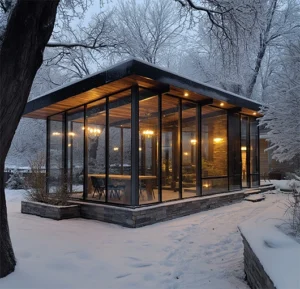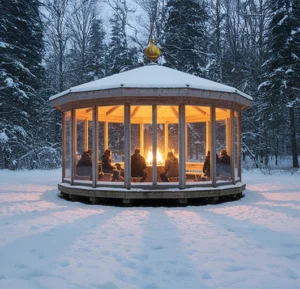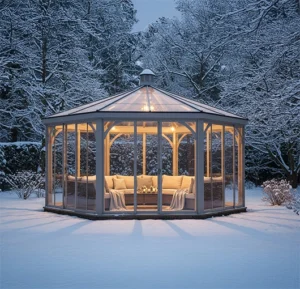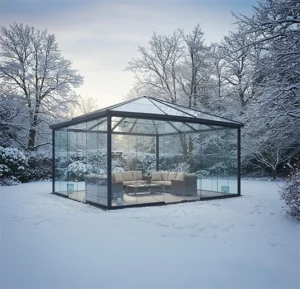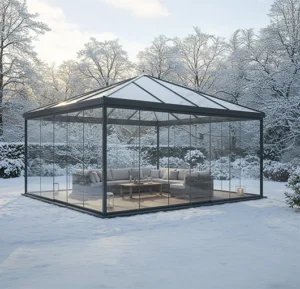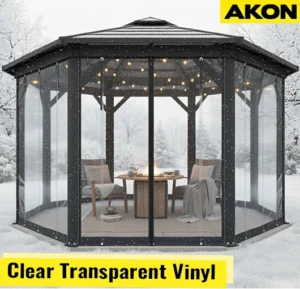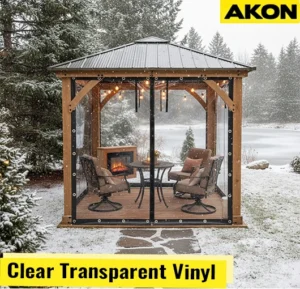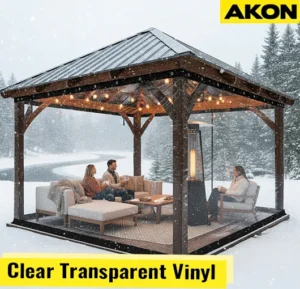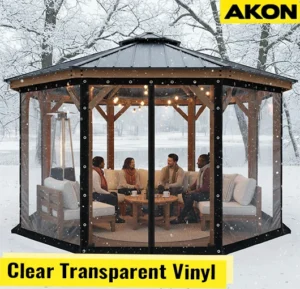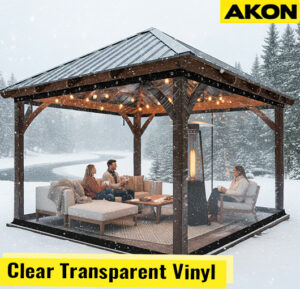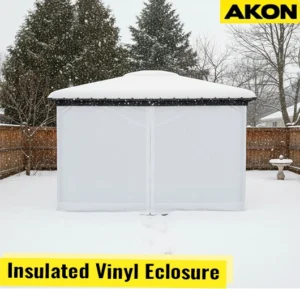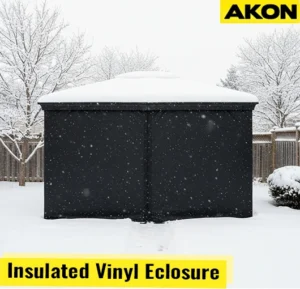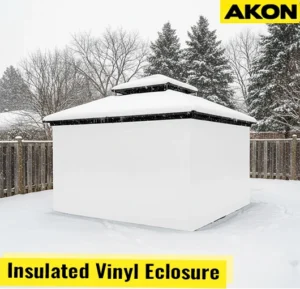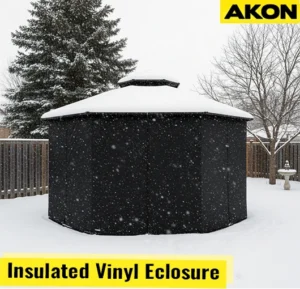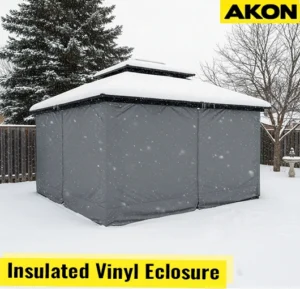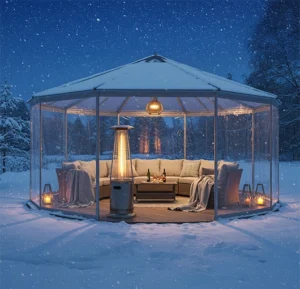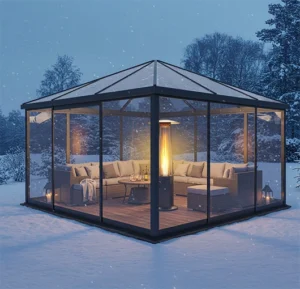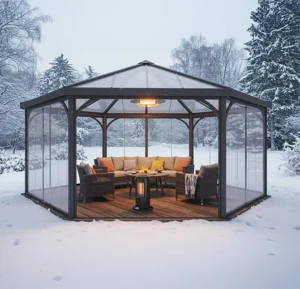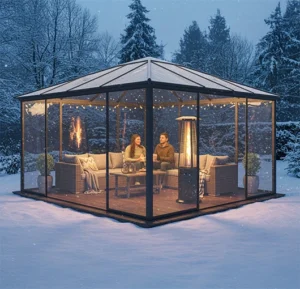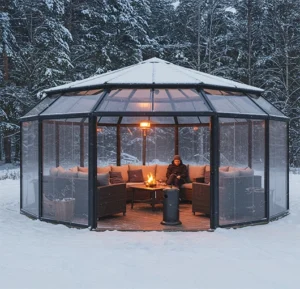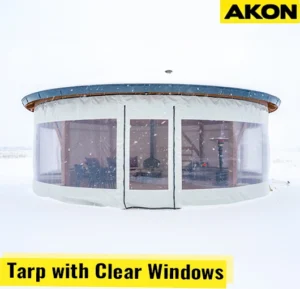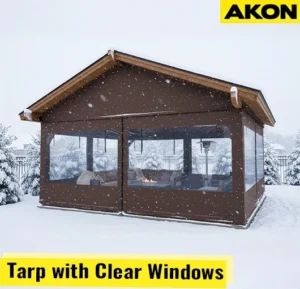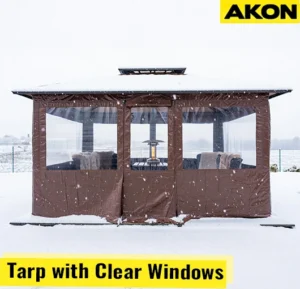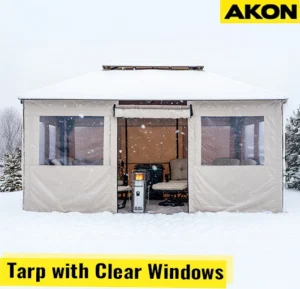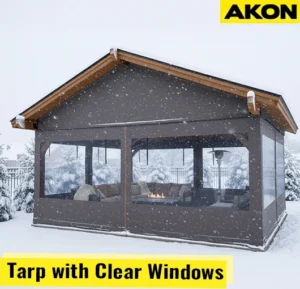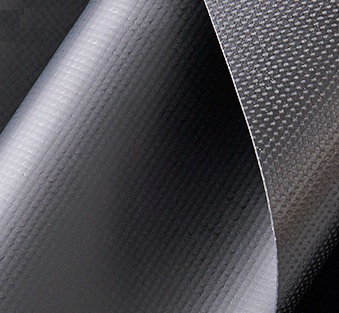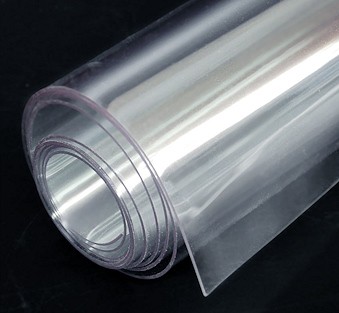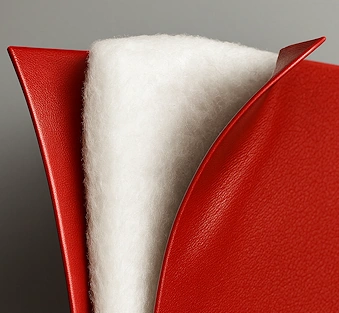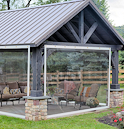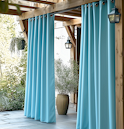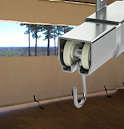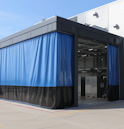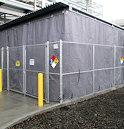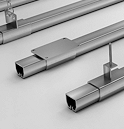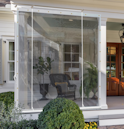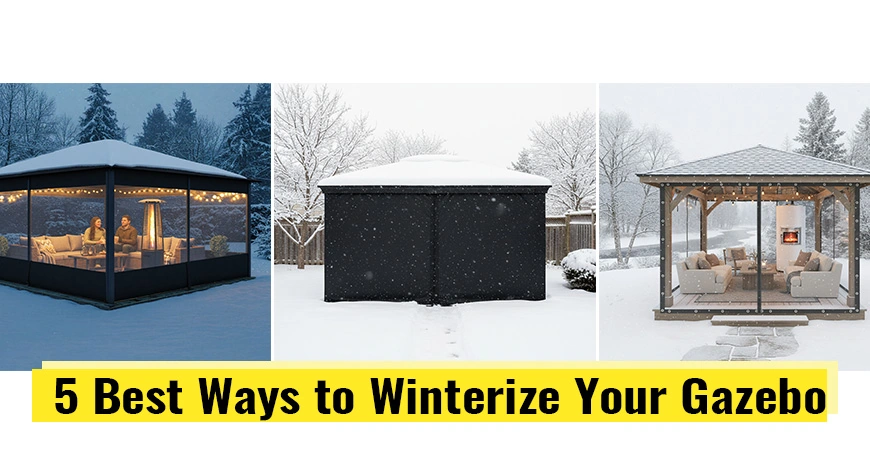
Overview
Most people cover up their gazebos when fall arrives and don't think about them again until spring. But here's the thing: your gazebo doesn't need to sit empty for six months of the year. With some smart winterizing, that outdoor space can stay useful even when there's snow on the ground.
More homeowners are figuring out ways to extend the life of their outdoor spaces. Makes sense when you think about it. Why let a perfectly good structure go to waste just because the temperature drops? Whether you want a place to drink your morning coffee while watching the snow fall, or you need extra space for holiday guests, a winterized gazebo solves a real problem.
Why Bother Winterizing?
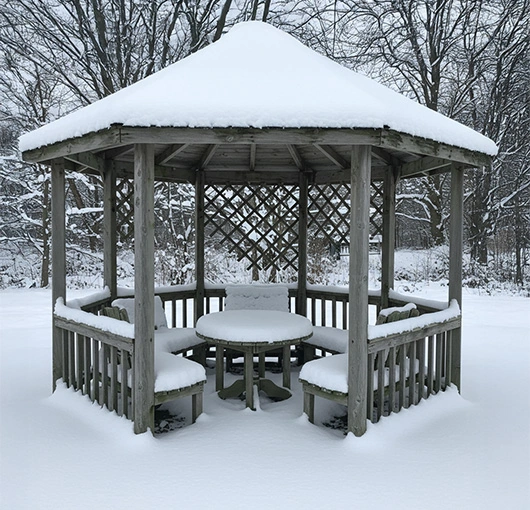
Let's talk about what you actually get out of winterizing your gazebo. First off, you've already spent good money on that structure. Leaving it unused half the year feels wasteful. But there's more to it than just getting your money's worth.
A winterized gazebo gives you something pretty special. You can sit outside in comfort during a snowstorm. You can set up a home office with actual natural light (not just another corner of your bedroom). Some people even use them for small winter parties. The space stays protected but you're not completely cut off from the outdoors.
There's also a practical benefit. Weather beats up outdoor structures. Wind, snow, ice... all of that takes a toll. When you winterize properly, you're protecting the gazebo itself. So you're not just making it usable, you're making it last longer.
Solutions for Winterizing Your Gazebo
Glass Panel Enclosures
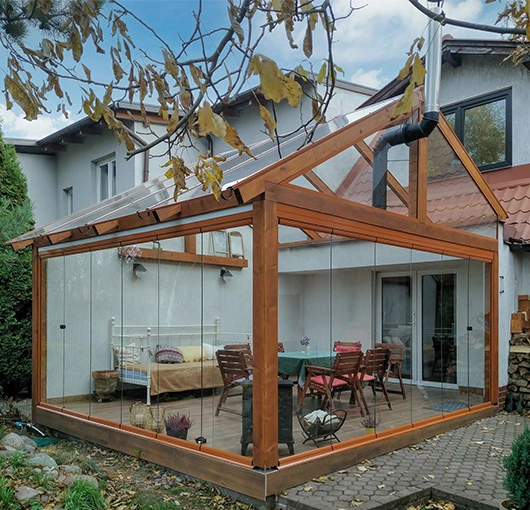
The permanent solution. This solution transforms your gazebo into a beautiful mini sunroom with glass panels mounted in frames. It creates an elegant, polished look while providing excellent year-round protection from all kind of elements.
This is a premium investment, typically running several thousand dollars with professional installation. The glass panels create a fixed enclosure, which gives you reliable protection season after season. You'll want to keep the glass clean to maintain those crystal-clear views, and it's worth noting that glass panels can be replaced individually if needed. This solutions is ideal if you're looking for consistent shelter rather than the option to open things up on milder days.
Clear Vinyl Curtains
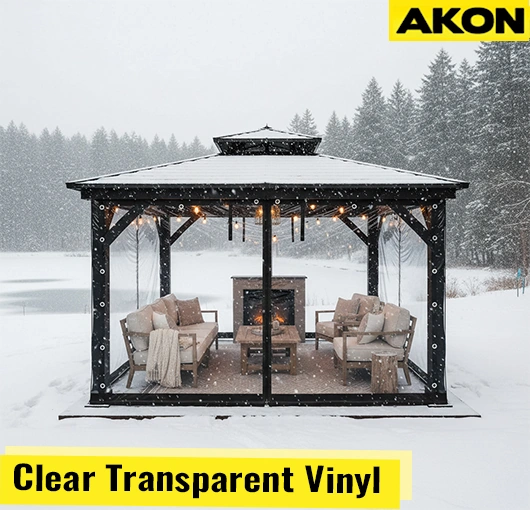
AKON's Heavy-duty clear vinyl blocks wind and snow while maintaining your view of the outdoors. You can see right through them, which keeps the space feeling open and airy while natural light flows in freely.
The standout feature is their flexibility. Each panel rolls up independently, so you have complete control over your setup. Want to enjoy a mild afternoon? Roll them all up. Dealing with wind from one direction? Keep that side closed and leave the others open. They're built with industrial grommets and reinforced edges, which means they're designed to last through multiple seasons of use.
Insulated Vinyl Enclosures
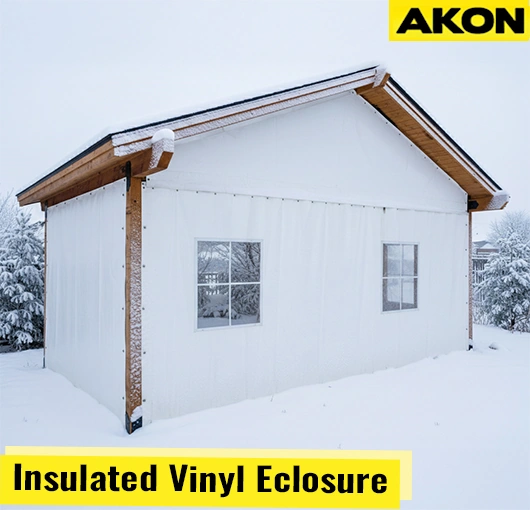
For those who want to actually heat their gazebo through winter, AKON's Insulated Vinyl Enclosures are designed specifically for that purpose. These feature insulation built directly into the vinyl layers, which means the heat you generate stays inside rather than escaping into the cold air.
This makes them ideal if you're planning to use your gazebo as a workshop or studio space during the colder months. While the insulation does reduce your view of the snow outside compared to clear vinyl, AKON allows you to customize your enclosure and add vision panels that let light in and give you views of the outdoors. You get the benefit of a warm, comfortable space that's actually usable in winter, which makes the slightly reduced visibility a worthwhile exchange.
Polycarbonate Panels
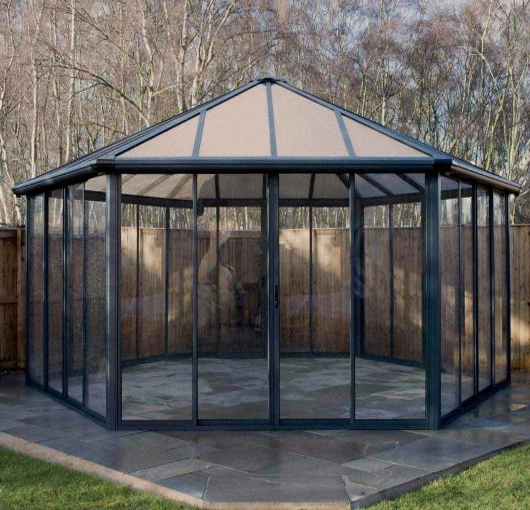
These are the plastic alternative to glass, and they have some real advantages. They're lighter, won't shatter if something hits them, and cost less than glass. You can get them clear or tinted, and they can take a hit without breaking.
The main thing to watch for is scratching. Over time, the surface picks up scratches that can cloud your view. They also expand and contract when temperatures change, so you'll need a frame system that accounts for that movement to avoid gaps or warping. Like glass panels, once you install them, they are permanent. If you want the option to open things up in nice weather, this isn't the way to go. But if you're after a permanent setup that's more forgiving than glass, they're a solid choice.
Tarp with Clear Windows
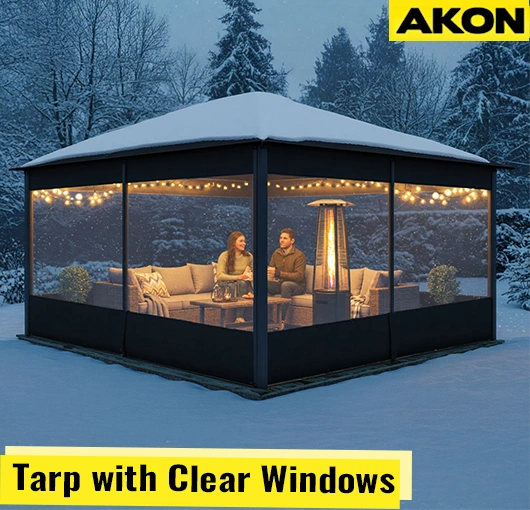
AKON's Tarp with Clear Windows is the heavy-duty option for serious weather conditions. These are professional-grade tarps built to handle harsh winters, with clear window panels strategically placed throughout so you're not completely closed off from the outdoors. You still get views and natural light coming through.
They really shine in places that deal with heavy snow and strong winds. The durability is there when you need it most. What makes them particularly appealing is the cost, you're getting professional-level protection at a fraction of what you'd pay for other enclosure options. This is an ideal choice if budget is a consideration and you need something that works well during the winter.
Finding the Right Enclosure for Your Gazebo
Compare Your Options
You've decided to enclose your gazebo, but now you're staring at a dozen different options wondering which one actually makes sense for your situation. It's tough to know what really matters when you're just trying to enjoy your outdoor space without getting soaked or frozen out. This comparison cuts through the confusion and lays out exactly what each enclosure type offers, so you can stop second-guessing and pick the one that actually fits how you live.
| Solution | Materials | Investment Cost | Effectiveness | Durability | Installation | All-Year Use |
|---|---|---|---|---|---|---|
| Glass Panel Enclosure | ✓ Tempered glass & frames | ✗ Highest cost | ✓ Excellent seal | ✓ Long-lasting | ✗ Pro install | ✓ 4-season use |
| Clear Vinyl Enclosure | ✓ Clear PVC/vinyl | ✓ Economical | ✓ Strong wind/rain block | Good; avoid scratches | ✓ DIY friendly | Good; roll up in summer |
| Insulated Vinyl Enclosure | ✓ Insulated vinyl + panels | $$$ Mid–High | ✓ Best heat retention | Very good; inspect seams | DIY/Pro install | ✓ Excellent with heaters |
| Polycarbonate Enclosure | ✓ Twin/solid polycarbonate | $$$ Mid–High | ✓ Great barrier | ✓ Very durable | Pro/advanced DIY | ✓ Very good year-round |
| Tarp with Clear Windows | ✓ Vinyl tarp + windows | ✓ Lowest cost | Fair; basic protection | Fair–Good | ✓ Easiest setup | Fair; seasonal best |
Why Vinyl Curtains Work (When Other Solutions Don't)
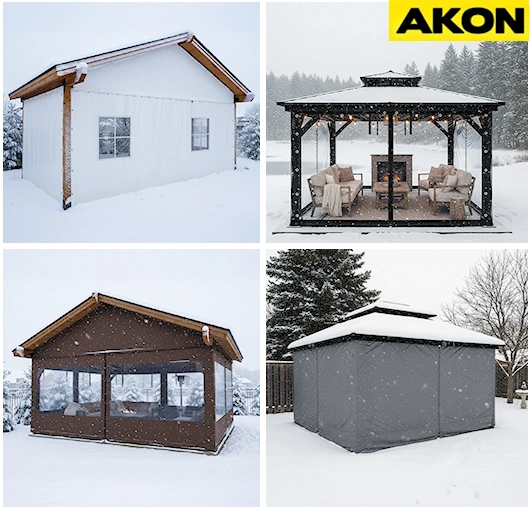
Most gazebo enclosures make you choose between weather protection and flexibility. Vinyl curtains give you both protection and flexibility in one solution. Each panel works on its own and rolls up when you don't need it. On nice days, you can open everything up. When the weather changes, you lower just the panels you need. This means you have control year-round instead of being stuck with a setup that only works in one season.
Clear vinyl keeps your view while protecting you from the elements. Your gazebo stays bright with natural light coming through, and you can still see outside. At the same time, you're blocking wind, rain, and snow. The space stays comfortable without feeling closed off.
These curtains are made to last. Heavy-duty vinyl with reinforced edges and industrial grommets holds up to weather season after season. You get solid protection without paying for expensive installation or committing to a permanent structure like glass or polycarbonate.
Easy Install
Outdoor curtains come with grommets at the top making hanging the curtains quick and easy with or without the curtain track.
Inexpensive
Outdoor curtains are about 1/3rd of the cost of other separation methods such as rigid walls or panel systems and are easy to store.
Temperature Control
Keep consistent temperatures inside more consistent for a more comfortable work environment and pull open when not needed.
Wind Blocking
Keep the wind and rain out when the weather turns nasty but still have the ability to pull open the curtain when its nice or you need access.
Frequently Asked Questions
Winterizing your gazebo is a smart way to keep your outdoor space comfortable all year, but we know you may have some questions first. For example, you want to know how much it will cost, how long it will last, how to install it, and how to maintain it. So, we created this Frequently Asked Questions (FAQ) page to answer the most common questions people have about gazebo enclosures. Read on to find out how they work, how long they last, and why they're one of the best ways to protect your gazebo during winter.
What's the best way to winterize a gazebo?
Clear vinyl curtains are the most practical option for most homeowners. They provide weather protection while maintaining visibility and natural light. Unlike permanent solutions, vinyl curtains roll up when you don't need them and work independently on each side. They're durable enough to handle snow and wind while costing significantly less than glass or polycarbonate installations.
How much does it cost to winterize a gazebo?
Costs range from a few hundred dollars for heavy-duty tarps to several thousand for glass panel installations. Clear vinyl curtains typically fall in the mid-range at $500-$1,500 depending on gazebo size. Insulated vinyl options cost more but allow you to heat the space. Budget solutions like tarps with windows offer professional-grade protection at the lowest price point.
Can I winterize my gazebo myself?
Yes, most vinyl curtain systems are designed for DIY installation. They attach using grommets, hooks, or tracks that you can install with basic tools. Glass and polycarbonate panels typically require professional installation. Tarps with windows are the easiest to install yourself. The installation difficulty depends on the enclosure type you choose and your gazebo's existing structure.
What materials work best for gazebo winter enclosures?
Heavy-duty clear vinyl offers the best balance of protection, visibility, and flexibility for most situations. Glass provides premium aesthetics but costs more and is permanent. Polycarbonate panels resist shattering but scratch easily. Insulated vinyl works best if you plan to heat the space. Tarps with clear windows handle extreme weather at the lowest cost.
Do clear vinyl curtains really keep the cold out?
Yes, heavy-duty vinyl curtains block wind effectively and create a barrier against cold air. They won't insulate like heated walls, but they significantly reduce wind chill and keep your gazebo more comfortable. For heating a gazebo in winter, insulated vinyl enclosures work better as they have insulation built into the layers to retain warmth.
How long do vinyl gazebo enclosures last?
Quality vinyl curtains with reinforced edges and industrial grommets typically last 5-10 years with proper care. Lifespan depends on weather exposure, UV protection in the vinyl, and how often you roll them up and down. Heavy-duty options designed for commercial use tend to outlast residential-grade materials. Regular cleaning and proper storage during off-seasons extends their life.
Can I remove the enclosures in spring?
Vinyl curtains and tarps are designed to be seasonal and roll up or remove completely. Glass and polycarbonate panels are permanent installations that can't be easily removed. This flexibility is why many homeowners prefer vinyl—you get winter protection without losing your open gazebo experience during warmer months. Each panel typically operates independently for partial opening.
Are insulated vinyl enclosures worth the extra cost?
Yes, if you plan to heat your gazebo and use it as a workspace or studio during winter. The insulation built into the vinyl layers keeps heat inside instead of letting it escape. Standard clear vinyl works fine for wind and precipitation protection, but it won't retain heat. The investment makes sense for year-round use.
What's the difference between vinyl curtains and glass panels?
Vinyl curtains are flexible, removable, and cost less, while glass panels are permanent, more expensive, and require professional installation. Vinyl rolls up for seasonal use and won't shatter on impact. Glass provides a more finished look and doesn't scratch as easily, but once installed, you lose the option to open your gazebo completely.
How do I measure my gazebo for winter enclosures?
Measure the height from the top of your gazebo railing to the roof or canopy edge. Then measure the width of each opening you want to cover. For vinyl curtains, add a few inches for overlap. Most suppliers provide measuring guides specific to their products. Taking photos of your gazebo structure helps manufacturers recommend the right attachment method.
Can vinyl curtains withstand heavy snow?
Yes, heavy-duty vinyl curtains with reinforced edges handle significant snow loads. The vinyl itself is strong, but proper installation matters—industrial grommets and secure attachment points prevent tearing. Heavy snow should slide off the angled curtain surface. For extreme snow areas, tarps with clear windows or reinforced vinyl specifically rated for harsh weather perform best.
Do I need professional installation for gazebo enclosures?
It depends on the enclosure type. Vinyl curtains and tarps are DIY-friendly and typically attach with hooks, straps, or simple track systems. Glass and polycarbonate panels require professional installation because they need custom frames and precise fitting. If you're comfortable with basic tools and following instructions, most vinyl systems work well as DIY projects.
How do I clean vinyl gazebo curtains?
Use mild soap and water with a soft cloth or sponge. Rinse thoroughly and let them air dry before rolling up. Avoid abrasive cleaners or rough scrubbing that can scratch the surface. For stubborn dirt, a gentle pressure wash on low setting works. Clean regularly to prevent buildup and maintain clear visibility through the vinyl.
Can I heat my gazebo with vinyl enclosures?
Yes, but use insulated vinyl enclosures for better heat retention. Standard clear vinyl blocks wind but won't hold heat effectively. With insulated vinyl, you can use electric heaters or propane heaters safely. Ensure proper ventilation even with enclosures, especially when using fuel-burning heaters. The insulation keeps heat inside, making your gazebo comfortable in cold weather.
What happens to vinyl curtains in extreme cold?
Quality vinyl curtains remain flexible in cold temperatures down to around -20°F. Below that, vinyl can become stiff but typically won't crack if it's heavy-duty material. Cold-weather vinyl formulations handle freezing better than standard vinyl. The curtains warm up and regain flexibility quickly. Avoid forcing frozen curtains to roll up—let them thaw naturally first.
Are there different thicknesses of vinyl for gazebos?
Yes, vinyl curtains range from 10-gauge to 20-gauge thickness, with lower numbers being thicker and more durable. 12-gauge and 14-gauge are common for residential gazebos. Heavy-duty commercial options use 10-gauge or thicker. Thicker vinyl resists tearing and punctures better but costs more. For harsh climates, invest in thicker gauge vinyl with UV protection.
How do vinyl curtains attach to my gazebo?
Most vinyl curtains use industrial grommets along the edges that attach to hooks, straps, or track systems mounted on your gazebo frame. Some systems use turnbuttons for quick attachment and removal. Track systems allow the curtains to slide open and closed. The attachment method depends on your gazebo's structure—posts, railings, or roof edges all work with the right hardware.
Can I see through vinyl curtains clearly?
Yes, clear vinyl provides excellent visibility when new and well-maintained. The clarity is similar to looking through a clean window, though not quite as perfect as glass. Over time, scratches and UV exposure can reduce clarity, but quality vinyl with UV protection maintains good visibility for years. Regular cleaning keeps the view clear.
Do gazebo enclosures work in windy areas?
Yes, but proper installation is critical. Vinyl curtains with reinforced edges and secure attachment points handle significant wind. Make sure grommets are industrial-grade and attachment hardware is rated for your wind conditions. In extremely windy areas, consider tarps with reinforced panels or ensure your gazebo structure itself is properly anchored. Quality materials and installation matter more than enclosure type.
What's the best budget option for winterizing a gazebo?
Heavy-duty tarps with clear window panels offer the best protection at the lowest cost. They handle harsh weather conditions effectively and cost significantly less than vinyl curtains or permanent installations. While they don't offer the same visibility as full clear vinyl, the strategically placed windows provide enough light and view. They're durable and practical for serious winter weather on a budget.
Summary
Too many homeowners spend winters staring at their empty gazebo, thinking there's nothing they can do about it. That's not true. With the right protection, your gazebo works just as well in January as it does in July.
When you add up what you're actually losing, the numbers tell the story. Damaged furniture needs replacing. You waste money on heating if you try to use the space. And you've got months of outdoor living area sitting there unused. Proper gazebo protection pays for itself and gives you years of comfortable, usable space instead of watching it sit empty half the year.
Ready to Actually Use Your Gazebo This Winter?
Don't waste another season looking at outdoor space you can't enjoy. Clear vinyl curtains give you flexibility to open and close as needed. Insulated vinyl enclosures let you heat the space and work out there comfortably. Tarps with clear windows give you solid protection without spending a fortune. Whatever your situation and budget, there's an option that works.
Get started today with a solution designed for your gazebo's specific size and needs.

